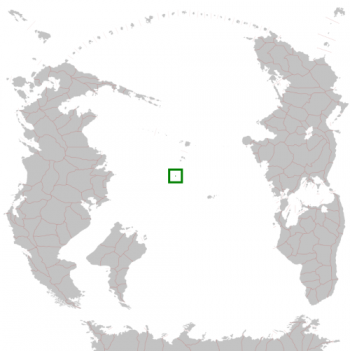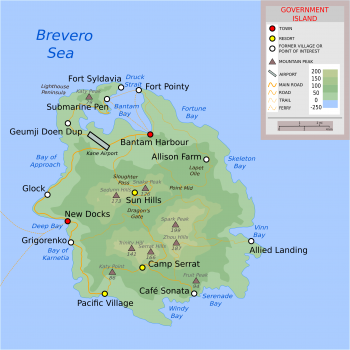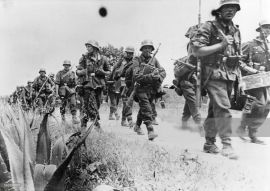Government Island (Pacifica): Difference between revisions
>Qwert No edit summary |
No edit summary |
||
| (3 intermediate revisions by 2 users not shown) | |||
| Line 9: | Line 9: | ||
| image_caption = Location of Government Island in the [[South Pacific (Pacifica)|South Pacific]] | | image_caption = Location of Government Island in the [[South Pacific (Pacifica)|South Pacific]] | ||
| image_alt = Location of Government Island | | image_alt = Location of Government Island | ||
| image_map = Gov isl.png | | image_map = Gov isl map.png | ||
| image_map_alt = Topographic map of Government Island | | image_map_alt = Topographic map of Government Island | ||
| image_map_size = | | image_map_size = | ||
| Line 70: | Line 70: | ||
| country1_area_km2 = <!-- or |country1_area_m2= or |country1_area_ha= --> | | country1_area_km2 = <!-- or |country1_area_m2= or |country1_area_ha= --> | ||
| demonym = | | demonym = | ||
| population = | | population = 3,000 to 10,000 | ||
| population_as_of = | | population_as_of = | ||
| population_footnotes = (depending on season) | | population_footnotes = (depending on season) | ||
| Line 89: | Line 89: | ||
}} | }} | ||
'''Government Island''', or less frequently '''Midway Island''' (Peonic: ''XX''; [[Sedunnic language (Pacifica)|Sedunnic]]: ''Beness''; etc), is a [[ | '''Government Island''', or less frequently '''Midway Island''' (Peonic: ''XX''; [[Sedunnic language (Pacifica)|Sedunnic]]: ''Beness''; etc), is a [[condominium]] located in the [[List of bodies of water of the South Pacific (Pacifica)#Brevero Sea|Brevero Sea]], in the centre of the [[List of bodies of water of the South Pacific (Pacifica)#South Pacific Ocean)|South Pacific Ocean]]. Covering an area of 221 km<sup>2</sup>, the island is characterised by a rocky shoreline, steep hills and sparse vegetation. It lacks major sources of fresh water which must be imported. Citizens of signatories of the Treaty of NN are allowed to disembark on the island. Permanent residency is hard to obtain and may be granted by the Government Island Council. The population varies between seasons and reaches its maximum of about 25,000 during the South Pacific summer. The main urban areas are New Docks and Bantam Harbour. | ||
== Etymology == | == Etymology == | ||
The [[Austral language (Pacifica)|Austral]] name Government Island first appears in ZZ maps during the [[Pirate Wars (Pacifica)|Pirate Wars]], likely referring to being the seat of the pirate kings and the pirate governance. The less frequently used name Midway Island refers to its position, roughly equidistant between [[South Pacific (Pacifica)#Cordilia |Cordilia]] and [[South Pacific (Pacifica)#Bailtem|Bailtem]]. Midway Island is likely a translation loan from one of the early seafaring nations, like [[Sedunn (Pacifica)|Sedunn]], [[Karnetvor (Pacifica)|Karnetvor]] or [[Huawan (Pacifica)|Huawan]]. | The [[Austral language (Pacifica)|Austral]] name Government Island first appears in ZZ maps during the [[Pirate Wars (Pacifica)|Pirate Wars]], likely referring to it being the seat of the pirate kings and the pirate governance. The less frequently used name Midway Island refers to its position, roughly equidistant between [[South Pacific (Pacifica)#Cordilia |Cordilia]] and [[South Pacific (Pacifica)#Bailtem|Bailtem]]. Midway Island is likely a translation loan from one of the early seafaring nations, like [[Sedunn (Pacifica)|Sedunn]], [[Karnetvor (Pacifica)|Karnetvor]] or [[Huawan (Pacifica)|Huawan]]. | ||
== History == | == History == | ||
There is no evidence of | There is no evidence of human presence on the island until the exploration and trading expeditions of the early 15th century. Situated midway between Cordilia and Bailtem, the island was an important node in the early cross-Pacific trade where supplies could be stored and exchanged. Several nations competed for control over the island, but none were successful in ousting its competitors. Lack of a clear jurisdiction led to lawlessness and the gradual increase in piracy. By the 17th century the island had become the major pirate stronghold in the ocean, severely threatening the cross-Pacific trade. Power was centralised in Bantam Harbour, a centuries old natural anchorage under a pirate king. A fort was built near Bantam Harbour to control and protect Druck Strait, the only access point to the harbour. Several smaller towns were founded, the most notable example being Jin Lin in the north-west. There are few surviving structures, but contemporary witnesses described Bantam Harbour as "lavish" and "royal" in architecture, meaning the residents were relatively wealthy. An estimated 15,000 people lived on Government Island by the 1750s. | ||
[[File:Old Port Royal - Project Gutenberg eText 19396.png|thumb|left|upright=0.9| Illustration of Bantam Harbour in the early 18th century.]]Piracy culminated in the Pirate Wars where major naval powers deployed their navies to end it. Severely weakened by the war, the pirates pledged to stop attacking ships crossing the ocean and where in return granted sovereignty of Government Island, founding the [[Free State (Pacifica)|Free State]] in the YY Accords. Its independence was granted by the signatories. | [[File:Old Port Royal - Project Gutenberg eText 19396.png|thumb|left|upright=0.9| Illustration of Bantam Harbour in the early 18th century.]]Piracy culminated in the Pirate Wars where major naval powers deployed their navies to end it. Severely weakened by the war, the pirates pledged to stop attacking ships crossing the ocean and where in return granted sovereignty of Government Island, founding the [[Free State (Pacifica)|Free State]] in the YY Accords. Its independence was granted and protected by the signatories. However, the new era of peace marks the start of the decline of Government Island. The end of piracy in the island meant and end for the accumulation of wealth and treasure. The young state also struggled to maintain order and many left the island. Only ten years after the end of the Pirate Wars, roughly half of the population remained, and by the end of the 18th century the population was roughly 7,000. | ||
In 1842 the Free | In 1842 the Free State secured a deal with several nations around the South Pacific Ocean to provide bunkering for steam-powered ships which helped stabilise its economy. A new fishing industry also helped boost the economy, as well to reverse the decline in population. By the end of the century, 25,000 people lived on the island. | ||
The YY Accords prevented the naval powers from establishing military presence on the island, and the Free State remained independent despite being under heavy pressure from certain nations, such as Karnetvor, who sought to gain control of the island due to its strategic value. In 1950, one year after the start of the [[Great War (Pacifica)|Great War]] Karnetvorian marines landed on the island and rapidly gained total control | The YY Accords prevented the naval powers from establishing military presence on the island, and the Free State remained independent despite being under heavy pressure from certain nations, such as Karnetvor, who sought to gain control of the island due to its strategic value. In 1950, one year after the start of the [[Great War (Pacifica)|Great War]] Karnetvorian marines landed on the island and rapidly gained total control. Government Island was then annexed and the population then numbering 41,000 was deported or expelled and gradually replaced by Karnetvorians. Most Government Islanders faced harsh conditions in the Karnetvorian camps and many did not survive. Much of the surviving historic buildings on the islands were brought down to build new structures intended for the military of Karnetvor and its allies. | ||
[[File:May-1941.-German-mountain-troops-advance-to-Crete..jpg|thumb|upright=0.9| Karnetvorian troops march on Bantam Harbour.]]In 1954, following the [[Great War (Pacifica)#Naval battle for Brevero Sea|Naval Battle for Bravero Sea]] Ryccian and Sedunnic troops landed on Government Island defeated the Karnetvorian garrison. Remaining historical buildings were devastated in the fighting. The island came under Sedunnic occupation and remained under Sedunnic jurisdiction two years after the end of the Great War, when its special status was restored. The few remaining Government Islanders were in general not interested in returning to the island. The original signatories of the YY Accords as well as all interested nations were invited to discuss the future of the island. The Treaty of NN established that Government | [[File:May-1941.-German-mountain-troops-advance-to-Crete..jpg|thumb|upright=0.9| Karnetvorian troops march on Bantam Harbour.]]In 1954, following the [[Great War (Pacifica)#Naval battle for Brevero Sea|Naval Battle for Bravero Sea]] Ryccian and Sedunnic troops landed on Government Island and defeated the Karnetvorian garrison. Remaining historical buildings were devastated in the fighting. The island came under Sedunnic occupation and remained under Sedunnic jurisdiction two years after the end of the Great War, when its special pre-war status was restored. The few remaining Government Islanders were in general not interested in returning to the island. The original signatories of the YY Accords as well as all interested nations were invited to discuss the future of the island. The Treaty of NN established that Government Island was to become a condominium. A joint board, called the Government Island Council, with representatives from the signatories would govern the island. | ||
Government Island was mainly inhabited by a scientists running | Government Island was then mainly inhabited by a scientists running smaller climate research stations and was at times completely deserted. In the 1970s, travelling by air became cheaper and more accessible, and several travel firms were allowed to build exclusive hotels on the island. The Government Island Council soon granted more people permanent residency to work in the hotels and the growing tourism sector. This led to a need for more housing, stores and other facilities, and more people were allowed to immigrate. The increased need for goods prompted the construction of a new port that could receive modern ships. New Docks grew to become the largest town of the island. There is now a permanent population of about 1,000 and full services exist on the island. The special status of Government Island Council is regarded as a guarantee for neutrality and equal terms. [[Café Sonata (Pacifica)|Café Sonata]], located in the cliffs in southern Government Island, has hosted several meetings with international leaders. Another notable consequence of Government Island being seen as neutral territory is that it was decided to let the [[Coordinated Universal Time (Pacifica)#Prime meridian|prime meridian]] pass through the Old Fountain in Bantam Harbour, providing a common reference for all nations. | ||
== Geography == | == Geography == | ||
| Line 127: | Line 127: | ||
== Transportation == | == Transportation == | ||
[[category:Collaboration stubs (Pacifica)]] | |||
Latest revision as of 18:00, 8 September 2022
 Location of Government Island in the South Pacific | |
 Topographic map of Government Island | |
| Geography | |
|---|---|
| Location | Brevero Sea |
| Archipelago | Bunker Islands |
| Area | 221 km2 (85 sq mi) |
| Length | 20 km2 |
| Width | 18 km2 |
| Administration | |
| Largest settlement | New Docks |
| Demographics | |
| Population | 3,000 to 10,000 (depending on season) |
| Languages | Austral |
| Ethnic groups | Peonic, Karnetvorian, Gianlucan, Sedunnic |
| Additional information | |
| Time zone | |
Government Island, or less frequently Midway Island (Peonic: XX; Sedunnic: Beness; etc), is a condominium located in the Brevero Sea, in the centre of the South Pacific Ocean. Covering an area of 221 km2, the island is characterised by a rocky shoreline, steep hills and sparse vegetation. It lacks major sources of fresh water which must be imported. Citizens of signatories of the Treaty of NN are allowed to disembark on the island. Permanent residency is hard to obtain and may be granted by the Government Island Council. The population varies between seasons and reaches its maximum of about 25,000 during the South Pacific summer. The main urban areas are New Docks and Bantam Harbour.
Etymology
The Austral name Government Island first appears in ZZ maps during the Pirate Wars, likely referring to it being the seat of the pirate kings and the pirate governance. The less frequently used name Midway Island refers to its position, roughly equidistant between Cordilia and Bailtem. Midway Island is likely a translation loan from one of the early seafaring nations, like Sedunn, Karnetvor or Huawan.
History
There is no evidence of human presence on the island until the exploration and trading expeditions of the early 15th century. Situated midway between Cordilia and Bailtem, the island was an important node in the early cross-Pacific trade where supplies could be stored and exchanged. Several nations competed for control over the island, but none were successful in ousting its competitors. Lack of a clear jurisdiction led to lawlessness and the gradual increase in piracy. By the 17th century the island had become the major pirate stronghold in the ocean, severely threatening the cross-Pacific trade. Power was centralised in Bantam Harbour, a centuries old natural anchorage under a pirate king. A fort was built near Bantam Harbour to control and protect Druck Strait, the only access point to the harbour. Several smaller towns were founded, the most notable example being Jin Lin in the north-west. There are few surviving structures, but contemporary witnesses described Bantam Harbour as "lavish" and "royal" in architecture, meaning the residents were relatively wealthy. An estimated 15,000 people lived on Government Island by the 1750s.

Piracy culminated in the Pirate Wars where major naval powers deployed their navies to end it. Severely weakened by the war, the pirates pledged to stop attacking ships crossing the ocean and where in return granted sovereignty of Government Island, founding the Free State in the YY Accords. Its independence was granted and protected by the signatories. However, the new era of peace marks the start of the decline of Government Island. The end of piracy in the island meant and end for the accumulation of wealth and treasure. The young state also struggled to maintain order and many left the island. Only ten years after the end of the Pirate Wars, roughly half of the population remained, and by the end of the 18th century the population was roughly 7,000.
In 1842 the Free State secured a deal with several nations around the South Pacific Ocean to provide bunkering for steam-powered ships which helped stabilise its economy. A new fishing industry also helped boost the economy, as well to reverse the decline in population. By the end of the century, 25,000 people lived on the island.
The YY Accords prevented the naval powers from establishing military presence on the island, and the Free State remained independent despite being under heavy pressure from certain nations, such as Karnetvor, who sought to gain control of the island due to its strategic value. In 1950, one year after the start of the Great War Karnetvorian marines landed on the island and rapidly gained total control. Government Island was then annexed and the population then numbering 41,000 was deported or expelled and gradually replaced by Karnetvorians. Most Government Islanders faced harsh conditions in the Karnetvorian camps and many did not survive. Much of the surviving historic buildings on the islands were brought down to build new structures intended for the military of Karnetvor and its allies.

In 1954, following the Naval Battle for Bravero Sea Ryccian and Sedunnic troops landed on Government Island and defeated the Karnetvorian garrison. Remaining historical buildings were devastated in the fighting. The island came under Sedunnic occupation and remained under Sedunnic jurisdiction two years after the end of the Great War, when its special pre-war status was restored. The few remaining Government Islanders were in general not interested in returning to the island. The original signatories of the YY Accords as well as all interested nations were invited to discuss the future of the island. The Treaty of NN established that Government Island was to become a condominium. A joint board, called the Government Island Council, with representatives from the signatories would govern the island.
Government Island was then mainly inhabited by a scientists running smaller climate research stations and was at times completely deserted. In the 1970s, travelling by air became cheaper and more accessible, and several travel firms were allowed to build exclusive hotels on the island. The Government Island Council soon granted more people permanent residency to work in the hotels and the growing tourism sector. This led to a need for more housing, stores and other facilities, and more people were allowed to immigrate. The increased need for goods prompted the construction of a new port that could receive modern ships. New Docks grew to become the largest town of the island. There is now a permanent population of about 1,000 and full services exist on the island. The special status of Government Island Council is regarded as a guarantee for neutrality and equal terms. Café Sonata, located in the cliffs in southern Government Island, has hosted several meetings with international leaders. Another notable consequence of Government Island being seen as neutral territory is that it was decided to let the prime meridian pass through the Old Fountain in Bantam Harbour, providing a common reference for all nations.